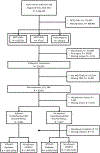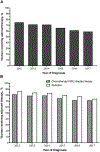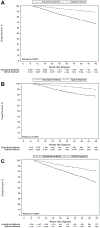Suboptimal therapy following breast conserving surgery in triple-negative and HER2-positive breast cancer patients
- PMID: 34176085
- PMCID: PMC8363582
- DOI: 10.1007/s10549-021-06303-7
Suboptimal therapy following breast conserving surgery in triple-negative and HER2-positive breast cancer patients
Abstract
Purpose: To assess potential disparities in guideline-concordant care delivery among women with early-stage triple-negative and HER2-positive breast cancer treated with breast conserving therapy.
Methods: Women ≥ 40 years old diagnosed with pT2N0M0 triple-negative or HER2-positive breast cancer treated with primary surgery and axillary staging between 2012 and 2017 were identified using the National Cancer Database (NCDB). The primary outcome was receipt of adjuvant systemic therapy and radiation concordant with current guidelines. Multivariable log-binomial regression was used to assess the prevalence of optimal therapy use across patient and cancer characteristics. Kaplan-Meier curves were used to assess 5-year overall survival. Multivariable Cox proportional hazards regression was used to compare the impact of optimal therapy on 5-year mortality.
Results: 11,785 women were included with 7,843 receiving optimal therapy. Receipt of optimal therapy decreased with age even after adjusting for comorbidities and cancer characteristics; other sociodemographic factors were not associated with differences in receipt of optimal therapy. Among patients who did not receive adjuvant systemic therapy, most were not offered the treatment (49%) or refused (40%). Overall 5-year survival was higher among women who received optimal therapy (89% [95% CI 88.0-89.3] vs. 66% [95% CI 62.9-68.5]). Patients who received suboptimal therapy were over twice as likely to die within 5 years of their diagnosis (adjusted HR 2.44, 95% CI 2.12-2.82).
Conclusion: Age is the primary determinant of the likelihood of a woman to receive optimal adjuvant therapies in high-risk early-stage breast cancer. Patients who did not receive optimal therapy had significantly diminished survival.
Keywords: Adjuvant chemotherapy; Adjuvant radiotherapy; HER2-positive breast cancer; Healthcare disparities; Triple-negative breast cancer.
© 2021. The Author(s), under exclusive licence to Springer Science+Business Media, LLC, part of Springer Nature.
Conflict of interest statement
Conflict of interest
The authors declare no conflicts of interest.
Figures



Similar articles
-
Population-Based Study on Cancer Subtypes, Guideline-Concordant Adjuvant Therapy, and Survival Among Women With Stage I-III Breast Cancer.J Natl Compr Canc Netw. 2019 Jun 1;17(6):676-686. doi: 10.6004/jnccn.2018.7272. J Natl Compr Canc Netw. 2019. PMID: 31200362
-
10 year survival after breast-conserving surgery plus radiotherapy compared with mastectomy in early breast cancer in the Netherlands: a population-based study.Lancet Oncol. 2016 Aug;17(8):1158-1170. doi: 10.1016/S1470-2045(16)30067-5. Epub 2016 Jun 22. Lancet Oncol. 2016. PMID: 27344114
-
Targeted Intraoperative Radiotherapy Tumour Bed Boost During Breast Conserving Surgery after Neoadjuvant Chemotherapy in HER2 Positive and Triple Negative Breast Cancer.Rev Recent Clin Trials. 2017;12(2):93-100. doi: 10.2174/1574887112666170201142458. Rev Recent Clin Trials. 2017. PMID: 28155607
-
Evaluation of Adjuvant Treatments for T1 N0 M0 Triple-Negative Breast Cancer.JAMA Netw Open. 2020 Nov 2;3(11):e2021881. doi: 10.1001/jamanetworkopen.2020.21881. JAMA Netw Open. 2020. PMID: 33211105 Free PMC article.
-
Adjuvant radiation therapy alone is associated with improved overall survival compared to hormonal therapy alone in older women with estrogen receptor positive early stage breast cancer.Cancer Med. 2020 Nov;9(22):8345-8354. doi: 10.1002/cam4.3443. Epub 2020 Sep 17. Cancer Med. 2020. PMID: 32942344 Free PMC article.
Cited by
-
10-year survival in female breast cancer patients according to ER, PR and HER2 expression: a cancer registry population-based analysis.J Cancer Res Clin Oncol. 2023 Jul;149(8):4489-4496. doi: 10.1007/s00432-022-04245-1. Epub 2022 Sep 21. J Cancer Res Clin Oncol. 2023. PMID: 36129548 Free PMC article.
-
Association of financial hardship and survival in working-age patients following cancer diagnosis in Taiwan.Oncologist. 2025 Jun 4;30(6):oyaf140. doi: 10.1093/oncolo/oyaf140. Oncologist. 2025. PMID: 40525912 Free PMC article.
-
Prognostic Factors and Models for Elderly (≥70 Years Old) Primary Operable Triple-Negative Breast Cancer: Analysis From the National Cancer Database.Front Endocrinol (Lausanne). 2022 Mar 17;13:856268. doi: 10.3389/fendo.2022.856268. eCollection 2022. Front Endocrinol (Lausanne). 2022. PMID: 35370936 Free PMC article.
References
-
- Network NCC: Invasive Breast Cancer (Version 6.2020) https://www.nccn.org/professionals/physician_gls/pdf/breast.pdf (2020)
MeSH terms
Grants and funding
LinkOut - more resources
Full Text Sources
Medical
Research Materials
Miscellaneous

